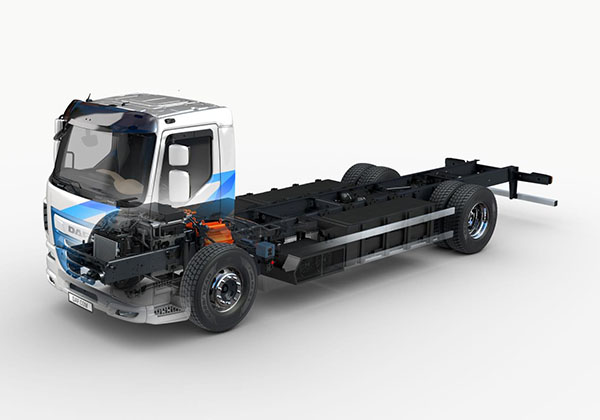DAF expands electric driveline to LF range
 With all-electric CF distribution trucks already in service in tractor and 6×2 rigid form, Paccar subsidiary DAF has now extended its battery-electric range down to the LF urban delivery sector. The 19-tonne 4×2 LF Electric has a claimed range of up to 280 km, and, like the rest of the DAF LF range, will be built in the UK at Leyland.
With all-electric CF distribution trucks already in service in tractor and 6×2 rigid form, Paccar subsidiary DAF has now extended its battery-electric range down to the LF urban delivery sector. The 19-tonne 4×2 LF Electric has a claimed range of up to 280 km, and, like the rest of the DAF LF range, will be built in the UK at Leyland.
A Dana electric motor with 250 kW nominal power (370 kW max) and nominal torque of 1,200 Nm drives the rear axle directly from the conventional position under the cab.
DAF hopes that many of the practical challenges faced by operators of electric trucks can be solved by the battery and charging technology employed in the LF Electric. Lithium Ferro Phosphate batteries are used on all DAF Electrics. These contain no cobalt or magnesium, have a higher energy density per litre than earlier battery types and a high degree of thermal safety. They are covered by a six-year DAF warranty.
The Combined Charging System is a special feature. This allows the truck to be charged through the regular electricity network and is ideal for when the truck returns to the home base at the end of the day. Through slow-charging (400V AC, 22 kW, three-phase), the battery pack can be charged from 20 to 80 per cent in six-and-a-half hours. A full charge (zero to 100 per cent) takes up to 12 hours. If dedicated equipment is available, fast charging the batteries (650V DC, 150 kW) will only take 60 minutes from 20 to 80 per cent, or two hours for a full charge.
As an option, the new DAF LF Electric is available with a 400V e-PTO for powering auxiliary equipment such as an electric cooling installation or an electro-hydraulic crane. This eliminates the need of a separate generator and will result in a full ‘zero emission’ distribution truck.
The LF Electric is initially available as a 19-tonne rigid, with a choice of 5.3 or 5.85 metre wheelbases. The truck offers a body and payload allowance of 11,700 kilograms, which is sufficient for the majority of city distribution applications. Production starts in May.











